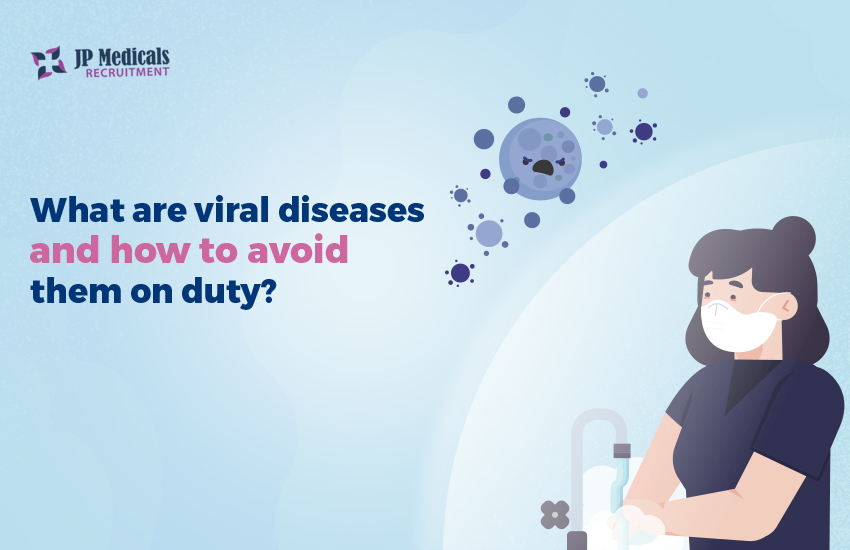The topic “virus diseases” might sound too common among healthcare workers, but they definitely need attention. Tiny infectious agents, viral diseases are often made up of DNA or RNA, enclosed in a coat of protein. This blog is all about that and how as healthcare workers you have to prevent yourself, especially while on duty.
What are viral diseases?
Viral diseases are any illness or health condition that are caused by viruses.
They are often protein coated, tiny germ-like structures that invade the cells in one’s body, and multiply , and then produce to form many more viruses like themselves.
During the process they can damage or destroy the cells and make one fall sick, resulting in diseases like flu, common cold, and warts. Different viruses attack certain cells in your body, weakening your immune system causing disturbance to liver, respiratory system, or blood. Sometimes the resulting disease is serious including Ebola, Covid-19, or even HIV?AIDS.
In most cases, more than the antibiotics, immunity building fights off the virus. Some antiviral medicines and necessary vaccines can help treat common viral infections.
Are viral diseases contagious?
While some viral diseases are contagious, some aren’t. Some that spread from person to person are flu, HIV, herpes, common cold and flu. There are some that easily spread through the bite of an infected insect.
Types of viral diseases

Respiratory viral diseases: These are contagious and basically infect both the lower and upper parts of the respiratory tract. Symptoms include a runny/stuffy nose, fever, body ache, coughing or sneezing.
Examples of respiratory diseases include flu, severe acute respiratory syndrome (SARS), common cold, adenovirus infection, respiratory syncytial virus infection, and parainfluenza virus infection.
Gastrointestinal viral diseases: Also referred to as stomach flu, this type of virus affects the digestive tract and is contagious, leading to gastroenteritis. Common symptoms include abdominal cramps, vomiting, and diarrhoea. Some examples include astrovirus infection, norovirus infection, rotavirus infection, etc.
Exanthematous viral disease: This type of viral disease causes skin rashes, which is highly contagious including measles virus, measles, roseola, smallpox, and shingles.
Hepatic viral diseases: This causes liver inflammation known as viral hepatitis A, hepatitis B, hepatitis C and yellow fever virus, etc.
Cutaneous viral diseases: This causes papules or lesions on the skin and they take time to cure. Some examples include warts, genital or oral herpes, hemorrhagic viral diseases. Some of the symptoms are body aches, high fever, weakness, bleeding from mouth/ears, under the skin, or in internal organs. Examples include ebola, dengue, and yellow fever.
Neurologic viral diseases: This type of virus infect the brain and its encircling tissues, leading to neurologic diseases. This can lead to a range of symptoms like fever, drowsiness, confusion, and seizures. Some neurologic viral diseases include polioviral meningitis, rabies, viral encephalitis, etc.
How do these viral diseases transfer?
The viral diseases can spread through a variety of ways. Before understanding how to prevent them, it is wise to know how they transfer.
- They majorly transmit airborne infection. Through coughs and sneezes, they release airborne pathogens.
- By touching contaminated food or objects, the pathogens from a person’s faeces easily transmit to other objects or food, if the hands are dirty.
- Through skin contact the pathogens easily transfer. Sharing clothing, personal items, or objects could lead to viral transmission.
- By contact with body fluids the pathogens in like saliva, faeces, or urine easily transmit people’s body through abrasions, cuts or mucus membranes (of the mouth and eyes)
- They spread through certain body fluids like semen, vomit, breast milk, vaginal discharge, and pus.
- Some internal fluids from the stomach, heart, lungs, can also transmit disease
- Clear fluids like sweat, urine, tears, saliva could be contagious when mixed with blood.
- When your skin is with crack, rash or cut, the mucus splash could transmit too, but the risk is lower.
How to avoid catching viral diseases while on duty?
You can protect yourself from infection by:
- Strictly adhering to the basic infection control regulations and good hand hygiene methods in your workplace like washing hands, covering cuts while treating patients, etc.
- Always use protective gears like goggles, gloves, masks to prevent from infectious materials
- While giving care to infected patients treat all bloody fluids like they are infectious
- Safety handle and dispose sharp instruments and needles in appropriate places
- Get properly immunised with right vaccines and preventive medicines
- Do not share any personal items like clothing, razors, toothbrushes, towels, shavers with anyone.
- Follow infection control and workplace cleanliness like regularly washing floors, bathrooms, surfaces using disinfectants
- Dealing with contagious blood fluids like saliva, blood, urine carefully with gloves
- Handling infectious waste by wearing heavy duty gloves
- Always handle contaminated sharps with the barrel
- Accumulate information about common health question infections to stay preventative
As healthcare workers, you know what it is to be infected with viral diseases. Therefore it is necessary to prevent yourself from common viral diseases first; a little carefulness could impact on others as well. Take good care of yourself to prevent workplace illnesses!





